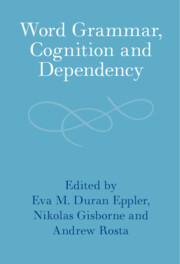Refine search
Actions for selected content:
6584 results in Grammar and Syntax
5 - The Metaphorical Bases of Constituency and Dependency
-
-
- Book:
- Word Grammar, Cognition and Dependency
- Published online:
- 19 December 2024
- Print publication:
- 02 January 2025, pp 126-143
-
- Chapter
- Export citation
List of Contributors
-
- Book:
- Word Grammar, Cognition and Dependency
- Published online:
- 19 December 2024
- Print publication:
- 02 January 2025, pp xii-xii
-
- Chapter
- Export citation
6 - From Social Psychology to Cognitive Sociolinguistics
-
-
- Book:
- Word Grammar, Cognition and Dependency
- Published online:
- 19 December 2024
- Print publication:
- 02 January 2025, pp 144-162
-
- Chapter
- Export citation
Index
-
- Book:
- Word Grammar, Cognition and Dependency
- Published online:
- 19 December 2024
- Print publication:
- 02 January 2025, pp 297-300
-
- Chapter
- Export citation
9 - Dependency Grammar and Subordination
-
-
- Book:
- Word Grammar, Cognition and Dependency
- Published online:
- 19 December 2024
- Print publication:
- 02 January 2025, pp 200-230
-
- Chapter
- Export citation
Figures
-
- Book:
- Word Grammar, Cognition and Dependency
- Published online:
- 19 December 2024
- Print publication:
- 02 January 2025, pp ix-x
-
- Chapter
- Export citation
Copyright page
-
- Book:
- Word Grammar, Cognition and Dependency
- Published online:
- 19 December 2024
- Print publication:
- 02 January 2025, pp iv-iv
-
- Chapter
- Export citation
Acknowledgements
-
- Book:
- Word Grammar, Cognition and Dependency
- Published online:
- 19 December 2024
- Print publication:
- 02 January 2025, pp xiii-xiv
-
- Chapter
- Export citation
Tables
-
- Book:
- Word Grammar, Cognition and Dependency
- Published online:
- 19 December 2024
- Print publication:
- 02 January 2025, pp xi-xi
-
- Chapter
- Export citation
Introduction
-
-
- Book:
- Word Grammar, Cognition and Dependency
- Published online:
- 19 December 2024
- Print publication:
- 02 January 2025, pp 1-18
-
- Chapter
- Export citation
3 - Grammar Change in the Network
-
-
- Book:
- Word Grammar, Cognition and Dependency
- Published online:
- 19 December 2024
- Print publication:
- 02 January 2025, pp 76-103
-
- Chapter
- Export citation
12 - Factors Influencing Dependency Distance
-
-
- Book:
- Word Grammar, Cognition and Dependency
- Published online:
- 19 December 2024
- Print publication:
- 02 January 2025, pp 276-296
-
- Chapter
- Export citation
8 - Ordinary French Houses
-
-
- Book:
- Word Grammar, Cognition and Dependency
- Published online:
- 19 December 2024
- Print publication:
- 02 January 2025, pp 178-199
-
- Chapter
- Export citation
4 - Word Formation Change in Word Grammar
-
-
- Book:
- Word Grammar, Cognition and Dependency
- Published online:
- 19 December 2024
- Print publication:
- 02 January 2025, pp 104-125
-
- Chapter
- Export citation
Contents
-
- Book:
- Word Grammar, Cognition and Dependency
- Published online:
- 19 December 2024
- Print publication:
- 02 January 2025, pp vii-viii
-
- Chapter
- Export citation
7 - Hudson on Heads
-
-
- Book:
- Word Grammar, Cognition and Dependency
- Published online:
- 19 December 2024
- Print publication:
- 02 January 2025, pp 163-177
-
- Chapter
- Export citation
10 - Verb Phrases as Attributive Nominal Modifiers
-
-
- Book:
- Word Grammar, Cognition and Dependency
- Published online:
- 19 December 2024
- Print publication:
- 02 January 2025, pp 231-251
-
- Chapter
- Export citation
2 - Raising in Phonology
-
-
- Book:
- Word Grammar, Cognition and Dependency
- Published online:
- 19 December 2024
- Print publication:
- 02 January 2025, pp 50-75
-
- Chapter
- Export citation
Dedication
-
- Book:
- Word Grammar, Cognition and Dependency
- Published online:
- 19 December 2024
- Print publication:
- 02 January 2025, pp v-vi
-
- Chapter
- Export citation

Word Grammar, Cognition and Dependency
-
- Published online:
- 19 December 2024
- Print publication:
- 02 January 2025
